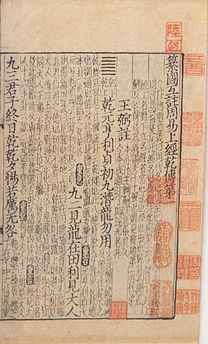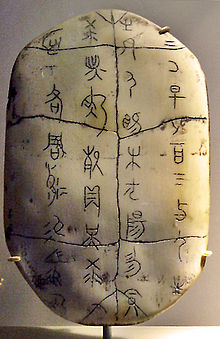
The I Ching, "Yijing(易经)", Classic of Changes or Book of Changes; also called "Zhouyi(周易)", The changes of the Zhou, is one of the oldest of the Chinese classic texts. The book is a symbol system used to identify order in random events. The text describes an ancient system of cosmology and philosophy that is intrinsic to ancient Chinese cultural beliefs. The cosmology centres on the ideas of the dynamic balance of opposites, the evolution of events as a process, and acceptance of the inevitability of change.
The Book of Changes is the most commented book of the old classics, said to be a composition of the mythical ruler Fuxi 伏羲, King Wen of Zhou 周文王, Duke Dan of Zhou 周公旦 and even Confucius. But instead, we can divide the text in the "original" listing of the 64 hexagrams and their respective line statements and the later "wing" commentaries. The main part with the listings can also be called "Changes of the Zhou", because it is the Zhou people's manual for the divination with milfoil stalks (shi 蓍). The former dynasty, the Shang 商, instead used heat crackings on oracle bones to divine. Its modern shape is very near to the original that must have been composed during the late Western Zhou Dynasty 西周.

Each of the hexagrams is composed of two of the Eight Trigrams (bagua 八卦). Each hexagram is named after its main fortune character, commented by a short statement (guaci 卦辭). Every single line of it, broken or solid (called "six" liu 六 and "nine" jiu 九 or "female" yin 陰 and "male" yang 陽), is commented by a line statement (yaoci 爻辭). The statements begin from bottom to top, counting as "beginning" (chu 初), two, three, four, five and "upper" (shang 上). The sequence of the 64 Hexagrams was not always the same. The commentary is very abstract and made room for occult prognostication, numerological and cosmological speculation and political and moral philosophizing during the Han Dynasty 漢 and the Song Dynasty 宋.
The ten "Wing Commentaries" (Shiyi 十翼) are products of the Han Dynasty and interprete the hexagram and its statements in a lexicological, symbolistic and philosophical way.
The important commentaries are that of Han time Kong Yingda 孔穎達, the Tang period 唐 scholar Lu Deming 陸德明 and the Song Dynasty Neo-Confucian Zhu Xi 朱熹. Still the best western translation is that of James Legge and the German one by Richard Wilhelm.
The Eight Trigrams (Bagua 八卦) are:
Qian 乾 (the Creative; Heaven)
Kun 坤 (the Receptive; Earth)
Kan 坎 (the Perilous Pit; Water)
Li 離 (the Clinging; Fire)
Zhen 震 (Exciting Power; Thunder)
Gen 艮 (Arresting Movement; Mountain)
Xun 巽 (Gentle Penetration; Wind)
Dui 兌 (Joy and Pleasure; Swamp)

The 64 Hexagrams:
First series 上經1 乾 Qian The Creative
2 坤 Kun The Receptive,Resting in Firmness
3 屯 Tun Initial Difficulty
4 蒙 Meng Youthful Folly, Obscurity
5 需 Xu Waiting, Nourishment
6 訟 Song Conflict
7 師 Shi The Army, Group Action
8 比 BiHolding Together, Union
9 小畜 Xiaoxu The Taming Force, Small Restraint
10 履 Lü Treading Carefully
11 泰 Tai Peace
12 否 Pi Stagnation
13 同人 Tongren Union of Men
14 大有 Dayou Great Possession, Abundance
15 謙 Qian Modesty
16 豫 Yu Harmony, Joy, Enthusiasm
17 隨 Sui Following
18 蠱 Gu Arresting Decay
19 臨 Lin Approach, Advance
20 觀 Guan Contemplation
21 噬嗑 Shihe Biting Through
22 賁 Bi Adornment
23 剝 Bo Falling Apart
24 複 Fu Returning
25 無妄 Wuwang Correctness, Innocence
26 大畜 Daxu The Great Taming Force
27 頤 Yi Correctness, Innocence
28 大過 Daguo Excess
29 坎 Kan The Perilous Pit
30 離 Li The Clinging; Brightness
Second series 下經
31 咸 Xian Influence
32 恆 Heng Preseverance, Duration
33 遯 Dun Retreat
34 大壯 Dazhuang The Power of the Great
35 晉 Jin Progress
36 明夷 Mingyi Darkening of the Light; Intelligence Wounded
37 家人 Jiaren The Family
38 睽 Kui Disunion, Mutual Alienation
39 蹇 Jian Arresting Movement
40 解 Jie Removing Obstacles
41 損 Sun Decrease
42 益 Yi Increase
43 夬 Guai Removing Obstruction, Breaking Through
44 姤 Gou Encountring
45 萃 Cui Gathering Together
46 升 Sheng Ascending
47 困 Kun Oppression
48 井 Jing A Well
49 革 Ge Revolution
50 鼎 Ding The Cauldron
51 震 Zhen Thunder, Exciting Power
52 艮 Gen Mountain, Arresting Movement
53 漸 Jian Gradual Progress, Growth
54 歸妹 Guimei The Marrying Maiden; Propriety
55 豐 Feng Abundance, Prosperity
56 旅 Lü Traveling Stranger
57 巽 Xun Gentle Penetration
58 兌 Dui Joy, Pleasure
59 渙 Huan Dispersion
60 節 Jie Regulation, Restraining
61 中孚 Zhongfu Inmost Sincerity
62 小過 Xiaoguo Small Excesses
63 既濟 Jiji Completion
64 未濟 Weiji Before Completion

|
This article is based on the article Yijing from the free encyclopedia Wikipedia and it licensed under the double licence of GNU Free Documentation License und Creative Commons CC-BY-SA 3.0 Unported. On Wikipedia a list of authors for this article is available. This article has been adjusted and extended for the use on this website. |






